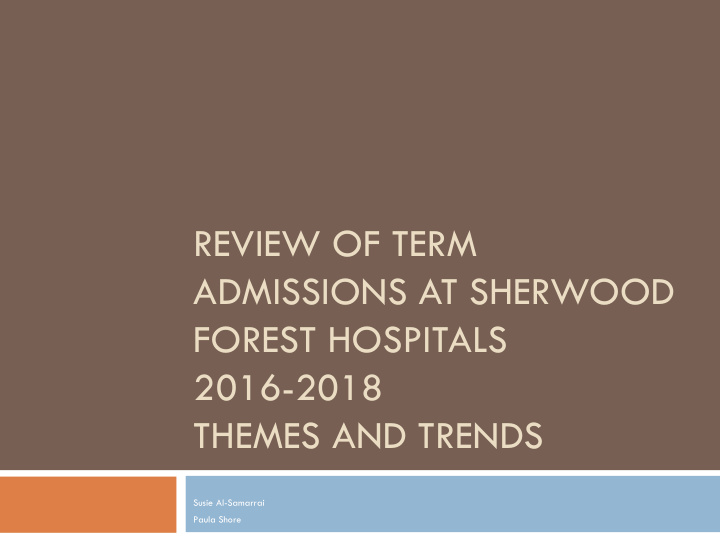



REVIEW OF TERM ADMISSIONS AT SHERWOOD FOREST HOSPITALS 2016-2018 THEMES AND TRENDS Susie Al-Samarrai Paula Shore
Introduction Since January 2016 a structured approach has been taken to review the term admissions to NNU at Kings Mill Hospital The core group members include a Consultant Obstetrician, Consultant Neonatologist, Neonatal Registrar (ST6) and Midwife The review meetings occur monthly and assess avoidability based on care given during pregnancy, birth and the postnatal period
Background Birth rate 2016 3678 Term admissions n=149 (4.0%) Birth rate 2017 3462 Term admissions n=109 (3.1%) Reviews conducted using ATAIN proforma to address learning points following detailed case note and BadgerNet information review
Results Reasons for Term Admission 2016-17 2017-18 60 50 40 30 20 10 0
Review of ‘Top 3’ Respiratory 2016 n=59 (40.9%) Vs 2017 n=48 (44%) Review in 2017 highlighted numbers born following planned LSCS Guidance changed to increase use of steroids and avoidance of non-indicated LSCS prior to 39/40 Current antenatal steroid uptake rate 90% (NNAP benchmark 86%) TTN rate zero for 2017
Review of ‘Top 3’ Sepsis Audit in 2016 and revised guidance re ‘Care of Newborn’ – highlighted need for consistent identification of ‘red flags’ 2016 – n=30 (20.3%) of term admissions due to sepsis 2017 – n= 9 (7.3%) Represents a 69% reduction in admissions with timely identification of at-risk mothers and babies
Review of ‘Top 3’ Hypoxic-Ischaemic Encephalopathy (1-3) 2016 – 18.2% of term admissions (n=27) 2017 – 11% of term admissions (n=11) Represents 56% reduction in admissions due to HIE QIP undertaken around CTG interpretation in 2017 All midwifery staff attended 1-day CTG Masterclass Co-ordinating midwives and obstetricians all attended 2-day CTG Masterclass
Supporting Work Regional project to review CTG interpretation, adopting physiological interpretation undertaken from November 2017 SFH have key stakeholders in development of guideline and competency assessment package to be used to support training and implementation across the region
Supporting Work Term Admissions meeting has helped to drive ongoing shared learning through perinatal M&M meetings, local and regional governance meetings Adoption of the ATAIN proforma has helped address issues and unify results produced Also helps identify which babies may better be cared for in transitional care environment
Celebration of Good Practice Thermoregulation ☺ Hat on ☺ Skin-to-skin ☺ Early feed ‘ Three little steps’ campaign No admissions due to hypothermia in 2017
Celebration of Good Practice Each Baby Counts RCOG Flagship QIP – aim to reduce the number of babies who die or are left severely disabled as a result of incidents occurring during term labour Required to report all babies who are referred for therapeutic cooling to EBC as well as those who die in labour or in the first 7 days of life No term babies referred for cooling for more than 15 months from SFH No babies reported to EBC for more than 15 months
Next steps Waive 2 National Maternity and Neonatal workstream via Patient Safety Collaborative Reduce admissions related to hypoglycaemia ?Transitional Care facilities
Questions?
Thank you!
Recommend
More recommend